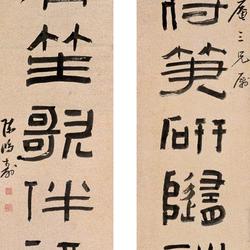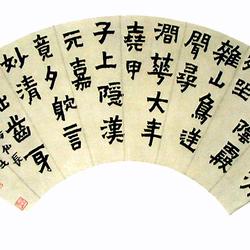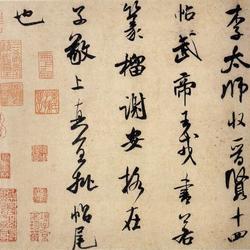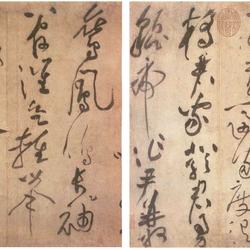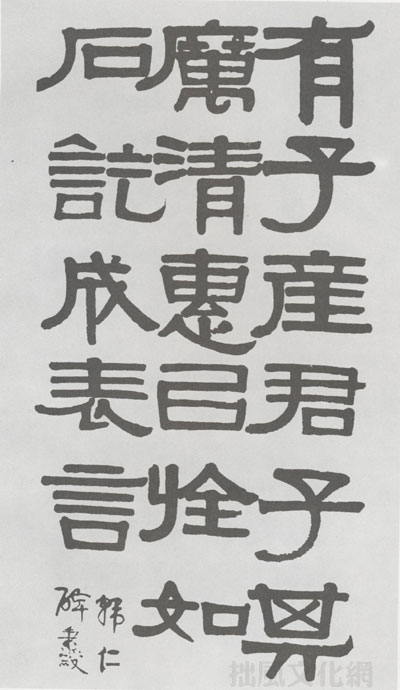
Yi Bingshou lived in the 19th year of Qianlong's reign in the Qing Dynasty - the 20th year of Jiaqing's reign (1754-1815), with the names Moqing and Mo'an. A native of Tingzhou, Fujian, he is also known as "Yitingzhou" by his old friends. His father, Yi Chaodong, was a Jinshi in the thirty-fourth year of Qianlong's reign (1769), and served as chief of the Ministry of Punishment, censor, and minister of Guanglu Temple. It is said in history that Yi Bingshou "learned from Zhu Gui's Neo-Confucianism, was taught by Ting Ting at a young age, studied Yin and inherited Fang, and emphasized the importance of establishing one's mind and practicing one's own learning." Later, he received the knowledge of Zhu Gui, a great scholar, and the high regard of Ji Xiaolan, who worshiped Ji as his teacher, and then worshiped Ji as his teacher. Liu Yong, the most famous calligrapher at that time, learned calligraphy from his teacher. Yi Bingshou was a Jinshi in the fifty-fourth year of Qianlong's reign (1789). He successively served as the head of the Ministry of Punishment and was later promoted to Yuan Wai Lang. In the fourth year of Jiaqing (1799), he was appointed the prefect of Huizhou, Guangdong. Due to a dispute with Ji Qing, his immediate superior and the governor of Guangdong and Guangxi, he was banished to the military station. After the edict was suspended, he was promoted to the prefect of Yangzhou. During his tenure, he was known for his "honest officials and good governance". In the seventh year of Jiaqing (1802), when Yi Bingshou was 54 years old, his father died of illness. He resigned and returned to his hometown with a coffin. Tens of thousands of Yangzhou citizens bid farewell to him in tears. Yi Bingshou himself died in 1815 at the age of 62. Later, people in Yangzhou admired his legacy and worshiped Yi Bingshou in the local "Three Sages Temple" (a temple dedicated to Ouyang Xiu, Su Shi, and Wang Shizhen), and renamed it the "Four Sages Temple".
Yi Bingshou was good at calligraphy during his lifetime. He also liked painting, seal cutting, and poetry. "Biographies of the History of the Qing Dynasty" said: "Bingshou Gong was divided into eight official scripts." "Guochao Xianshishi Luo" said that "the larger the official script is, the better it becomes, and it has an ancient and profound atmosphere." Together with Deng Shiru, he is also known as "Deng in the South and the North". It is also as famous as Guifu. It was noticed by later generations for its "superior official script, which made it shine in the calligraphy world in the Qing Dynasty" and was highly praised. The Qing Dynasty's "Zhao Dynasty Chronicles" says that "Mo Qing's calligraphy is like that of Li Xiya, and he is especially good at ancient official scripts. He only dislikes Zhao Wenmin, so he doesn't like his writings." Jiao Xun's "Diaoxianlou Collection" says that "the public's daily life is full of laughter and kindness, and he is a gentleman." Confucianism. At that time, he wetted ink and wrote official script, just like the old traces of Han and Wei people." Zhao Guang's "Tui'an Essays" said: "Yi Moqing and Gui Weigu came out, and they began to receive the true biography of Han Li from afar. Mo Qing was able to break away from Han Li and become a Confucian scholar. The bigger it is, the bigger and stronger it is." Jiang Baoling's "Mo Lin Jin Hua" said: "(Yibingshou) is especially famous for its contemporary seal script and official names. It is elegant and ancient, unique, and regular script has also entered Yan Pingyuan's family." He Shaoji's "Mo Lin Jin Hua" said: "Dongzhou Cottage Poetry Copy" praised Yi Bingshou: "My father-in-law made two seals in eight parts, making the ink as clear as lacquer and the paper as simple as slips. There is no post-Tang Dynasty style in cursive writing, and the cliffs slide over the rain and the moss relaxes. Don't keep the vulgar books thin and clear, and look down upon the gate of innocence. Taoist eye." Bao Shichen's "Yizhou Shuangji" said: "I first met Ninghua Yi Moqing, the prefect of Bingshou, in Yuanpu. Mo Qing is also a disciple of Liu Zhucheng. Because he once asked about the laws of Zhucheng, the prefect said:' My master taught the method and said: If the fingers are not dead, the painting will not be alive. The method is to place the tube on the tip of the big finger and the index finger, and slightly use the claw to support the outside of the tube, so that the big finger and the index finger make a circle, which is the method of Gu Longjing. It uses the big finger If the finger is tilted towards the index finger, it will form a phoenix eye. The method cannot be used to kill the finger, and it is not authentic." Wang Jiaoqi's poem said: "Mo Qing's calligraphy is also like a painting, and his pen and ink can communicate with the spirit." Yang Shoujing's "Xue Shu You" "Yan" said: "Mo Qing's Bafen calligraphy is based on the Han people, and his running calligraphy is based on Li Xiya's, which is particularly superb." Xiang Shen said: "Mo Qing's regular calligraphy on "Cheng Zhe Stele" is based on Li Xiya's running calligraphy, and the official script is directly into the Han Dynasty. That is, Deng Wanbai is also inferior to his ancient people, and he doesn't care about it." Li Xuan Gong said: "Tingzhou calligraphy came in and out of the Qin and Han Dynasties, and the seal scripts he made at that time were unique. That is to say, although his regular script originated from Shanyin and plains, He also collected and gained new ideas, and the spirit of metal and stone is also full of paper." Kang Youwei's "Guangyizhou Shuangji" said: "Tingzhou is good at eight points, and uses eight points to make real books, imitating "Diaobi" "Qian Wen", thin and vigorous." The contemporary Ma Zonghuo said in "Sui Yue Lou Bi Tan": "The world is called the Li of Yitingzhou because of its ancient clumsiness. However, clumsiness and sincerity exist, but they cannot be found in ancient times. It is unique. He used the official script to write running script and entered the palace of Lu Gong." Sha Menghai said: "Yi Bingshou is the authentic official script. Kang Youwei said that he was a master of collections, which is quite right. In fact, his works are not poor in style, and the writing is not good. Just separate yourself from others into the realm of immortality.”
His main ink writings handed down from generation to generation can be found in "Collection of Mo'an Collection". In 1971, Taiwan Popular Book Company published "Collection of Qing Yi Bingshou's Works". In October 1984, Shanghai Bookstore published "Selected Ink Calligraphy of Yi Bingshou's Official Script". Although he is capable of all four skills, he is best at official script. Its official script is one of the majestic and simple types among Han steles. Only the "Selected Official Script and Ink Calligraphy" published by the Shanghai Bookstore includes "Pei Cen", "Han Renming", "Yin Zhou Stele", "Kong Zhou Stele", "Zhang Qian Stele" and "Hengfang Stele" written by him. "wait. He is particularly effective at the "Hengfang Stele". According to Yi Bingshou's "Liuchun Caotang Poetry Copy", it is known that he wrote the "Hengfang Stele" as many as a hundred times. It integrates pre-Qin seal scripts, Han and Wei bricks, and Yan style styles into one furnace, and becomes a brand of its own.
Many of his official script couplets have been handed down to the world, such as the three-character couplet written in the third year of Jiaqing (1798), "Aspirations to the Tao, time is meritorious." The five-character couplet written in the fourth year of Jiaqing (1799), "Qing Guang is better to play with bamboo, leisurely elegance is better than listening to the piano." ." The five-character couplet written in the eighth year of Jiaqing (1803) "is a political voice for the officials of Han Dynasty, and the Jingyi is Dongjiangdu." The five-character couplet written in the ninth year of Jiaqing (1804) "always has ancient meanings and can be used to write new poems." The tenth year of Jiaqing (1805) The four-character couplet written "changes the temperament and cultivates the spirit." (The above can be found in "A View of Chinese Calligraphy Culture: Yi Bingshou's Calligraphy Art"). In addition, the five-character couplet collected by the Capital Museum and published in the Catalog of Ancient Chinese Painting and Calligraphy "comes from the harmony of mind and spirit, and directly captures the true nature of temperament" and the couplet presented to brother Yi Yuanjiu "advocates the distant traces of love and Fu, and the refined reason also reflects the Taoist heart." , the seven-character couplet published in Japan's "Complete Collection of Chinese Calligraphy" "more than three thousand years ago, 17 schools of writing are rare" and so on.
In addition to couplets, his official script works handed down from generation to generation include "Jin Shu Liu Yi's Biography Scroll" published in Japan's "Comprehensive Calligraphy Dictionary" and "Wei Shu's Biography Scroll" published in Japan's "Ming and Qing Calligraphy Illustrated Notes", Kyoto, Japan Collection of the museum, published in "Jielin Hanheng Square Stele" in Japan's "Complete Collection of Chinese Calligraphy".
It can be seen from the couplets that ancient and modern commentators say that he is good at writing large official script characters, which are "bigger and stronger, and magnificent." The characteristics of his official script works are more obvious. Comments on his official script works include "strict strictness, strangeness, broadness, and arbitrariness." "Vertical" characteristics. Critics also praised his calligraphy: "The strokes are written in the center, the head is hidden and the tail is protected, and the law is strong"; "The thickness of the strokes is roughly even, round and straightforward, full of ancient interest"; "The writing is powerful, elegant and fresh"; "Strong and ancient, horizontal and horizontal" "Vertical", "honest demeanor, insightful backbone", "elegant style, full of charm", "ancient and lush, simple, ethereal and elegant", "rich in stone and temple atmosphere" and so on.
His handed down running script works include the twelve lines of "Jie Lin Tang and Song Dynasty Calligraphy Screen", a total of 128 characters, collected by the Shanghai Museum and published in Japan's "Chinese Ming and Qing Calligraphy Famous Album". "Linliu Gongquan's Ruler Sketches" was written in the third year of Jiaqing (1798), with a total of 86 characters in four lines. It was published in the "Complete Collection of Chinese Calligraphy" in Japan. "Album of Self-written Poems", six lines totaling 41 characters, collected by Liaoning Provincial Museum and published in Japan's "Complete Collection of Chinese Calligraphy". "Seven Jue Poetry Scroll", with six lines and a total of 45 characters, was published in Japan's "Illustrated Notes on Calligraphy of the Ming and Qing Dynasties". "Laozi's Language Axis in Running Script", with three lines and ten characters in total, was published in the "Complete Collection of Chinese Calligraphy" in Japan. In addition, "Chinese Calligraphy Today" includes "Mr. Nanyuan's Running Script and Du Shi Album", which was photocopied by Zhenya Library in the 20th year of the Republic of China (1931) from the owner of Pingzhai.
During his lifetime, Yi Bingshou wrote the small regular script of Tang Yu Shinan, Ouyang Xun, Chu Suiliang, Liu Gongquan and others, the large regular script of Yan Zhenqing, and the "Lanting Preface", etc., which laid the foundation for his regular script. The running script work "Jue No Man Everywhere" written in the third year of Jiaqing has begun to show its unique style. By the time he wrote the regular script couplets written in the 10th year of Jiaqing's reign, "it's hard to learn from the ancients if you are afraid of being changed by the current," it has formed his calligraphy style of "old-fashioned, clumsy, and full of gestures." Critics say that his regular script can also "acquire everything and express new ideas", "the writing is based on the official method", "the seal letter and gold stone spirit overflows between the lines", "emotional and beautiful, free and easy to control, full of personality" , "It is due to the legacy of Lu Gong and the strength of the bones."
Critics say that his running calligraphy is "center-centered, not revealing, and contains solemnity, and the writing is all satisfactory." This is inseparable from his daily hard work on writing. According to Xie Zhangcheng's "Jianqi Shanzhuang Ci Hua": "Mo Qing learns to draw dozens of hundreds of strokes every day, and he has been tired since he was a child, until he is evenly rounded. If you can do this, your calligraphy skills will be strengthened." Comments on his "Mo Qing" The first screen (in regular script) among the four sections of "Jie Lin's Book Screen of the Tang and Song Dynasties" is "steady and neat in work, dignified and generous", "concentrated and broad", "seeing freedom and ease in calmness, breaking but not separated, harmonious but not flowing", "seeking in difference" Sameness, seeking differences in the sameness.” Commenting on the second screen (cursive script) among his four screens, it is a typical masterpiece that combines inscriptions and inscriptions. "It can be arbitrarily vertical and horizontal, soft on the outside and strong on the inside. It also looks free and elegant, casual and natural, which reflects his integrity and open-minded character." ." Commenting on his "Linliu Gongquan Ruler and Sketches": "It has both a strong and vigorous style of writing and a lively and simple style." The reviewer also believed: "On the whole, his running calligraphy has mostly facial expressions and Yang Ning style. , Lin Hejing, and Dong Xiangguang’s legacy, they are worthy of being called the masters of calligraphy in the mid-Qing Dynasty.”

